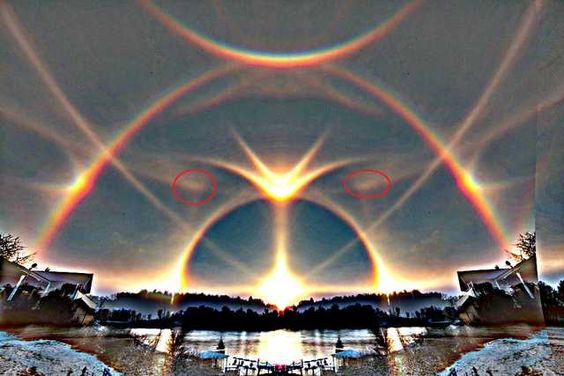Have you ever taken a walk on a winter’s day to find the sun flanked by two bright companions? These companions are known as sundogs, which appear as two bright pillars of light on either side of the shining sun in the winter sky.

A sundog is a concentrated patch of sunlight that is occasionally seen to the right or left of the sun, or even on both sides of our star simultaneously. Also called mock suns or parhelia, which means “with the sun,” sundogs are part of a family of atmospheric optical illusions that include moon haloes and sun haloes. These phenomena are all caused by the refraction of sunlight by ice crystals in the atmosphere.

Sundogs typically manifest as a pair of patches of light with subtle colors, appearing at the same altitude over the horizon as the sun. They can take on various forms, sometimes resembling colorful spots, and at other times, appearing so intense and bright that they seem like two additional suns in the sky.

The name “sundog” is believed to have origins in Greek mythology, although this is not the definitive origin. According to the Almanac, the name may reflect the belief that as Zeus, the father of all gods and the god of the sky in Greek mythology, walked his dogs through the sky, they often appeared as companions to the sun, resembling two “false suns.”

But what causes sundogs to form? Sundogs are formed when light passes through hexagonal plate crystals of ice suspended in cirrus or cirrostratus clouds located at altitudes of around 20,000 feet (6,000 meters) and higher, up to 40,000 feet (12,000 meters).
These ice crystals can also be found closer to the ground in extremely cold climates where temperatures drop below -22 degrees Fahrenheit (-30 degrees Celsius), a phenomenon known as “diamond dust.”

As these ice crystals descend, their hexagonal faces become approximately horizontal. When rays of sunlight enter through one side edge face and exit through another edge face inclined at 60 degrees to the first, the sunlight deviates by at least 22 degrees, depending on the angle at which it entered the ice crystal. This deviation causes the light to encircle the sun at a distance of 22 degrees, creating sun haloes. When the light is concentrated as spots next to the sun, also separated by 22 degrees, it appears as sundogs.

Interestingly, sundogs often have “tails” of light stretching out from them, which are created by the reflection of light from the vertical sides of the flat hexagonal ice crystals. These tails give a canine-inspired appearance to the phenomenon.

Sundogs can also appear as a sort of rainbow on either side of the sun. The inner edges of sundogs closer to the sun tend to have a reddish hue, while the outer edges are blue in color. The middles of sundogs tend to be yellow or orange. This variation in color is rooted in the physics of light that also gives rise to the ordering seen in rainbows.

White light from the sun consists of various colors. When this light passes through a prism-like medium, such as an ice crystal, it is split into its constituent colors. The refraction of light depends on its frequency, known as the index of refraction. Low-frequency, long-wavelength red light is refracted less strongly than high-frequency blue light, causing red light to stay closer to the sun, while blue light is dispersed further out. This effect creates the color variation seen in sundogs, similar to the ordering of colors in a rainbow.

Sundogs not only vary in color but also in shape and size, depending on the size of the ice crystals that create them. These hex
agonal crystals rarely remain perfectly horizontal as they descend through the atmosphere. Instead, they wobble as they fall to Earth, and the amount of wobbling increases with the crystal’s size.

So, the next time you take a winter stroll and witness the sun flanked by two bright companions, you’ll know that you are witnessing the beautiful atmospheric phenomenon known as sundogs, caused by the refraction of sunlight by ice crystals in the sky.